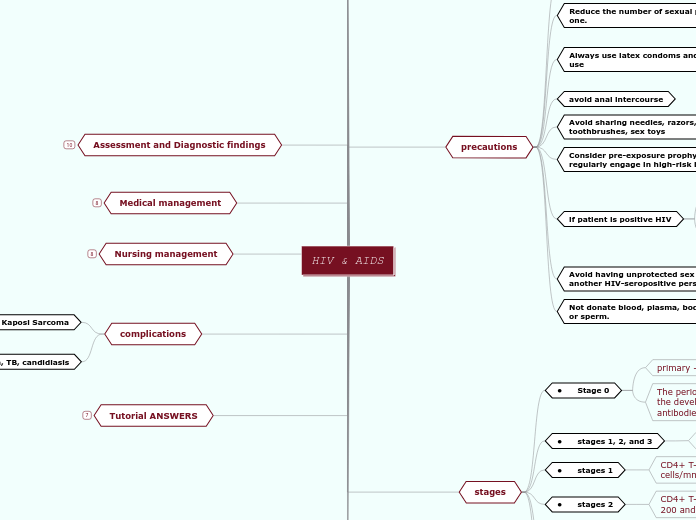HIV & AIDS
What is it?
mode of transmission
precautions
Abstain from exchanging sexual fluids (semen and vaginal fluid).
Reduce the number of sexual partners to one.
Always use latex condoms and don't re-use
If the patient is allergic to latex, nonlatex condoms should be used; however, they will not protect against HIV infection.
avoid anal intercourse
Avoid sharing needles, razors, toothbrushes, sex toys
Consider pre-exposure prophylaxis if regularly engage in high-risk behaviors.
if patient is positive HIV
Take ART regularly to achieve viral suppression.
Inform previous, present, and prospective sexual and drug-using partners of their HIV-positive status
Avoid having unprotected sex with another HIV-seropositive person
risk for cross-infection
Not donate blood, plasma, body organs, or sperm.
stages
• Stage 0
primary - acute infection
The period from infection with HIV to the development of HIV-specific antibodies
• stages 1, 2, and 3
based on the CD4+ T-lymphocyte count.
• stages 1
CD4+ T-cell counts drop to 500 to 1,500 cells/mm3 of blood
• stages 2
CD4+ T-lymphocyte cells are between 200 and 499
• stages 3
stage 3 when the count drops below 200 cells/mm3 of blood
the person is considered to have AIDS for surveillance purposes
• stages unknown
Cases with no information on CD4+ T-lymphocyte count or percentage
Clinical manifestations
Assessment and Diagnostic findings
Medical management
Nursing management
complications
Kaposi Sarcoma
Cutaneous signs may be the first manifestation of HIV; they can appear anywhere on the body and are usually brownish pink to deep purple.
pneumonia, TB, candidiasis
